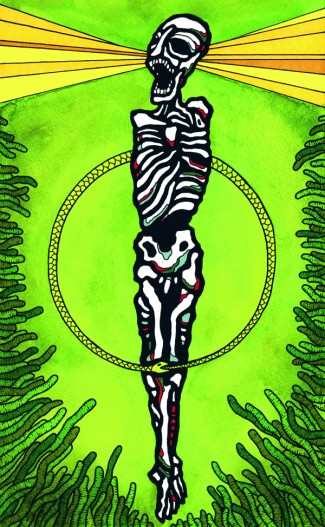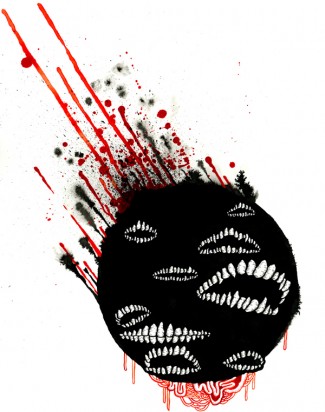Matt Kish owns a harpoon.
Self-taught artist Kish hit coffee tables with Moby-Dick in Pictures: One Drawing For Every Page in 2011. When Kish set out to illustrate Herman Melville’s classic in 2009, he threw up a website to share his project with friends and family. Day One: “Because I honestly consider Moby-Dick to be the greatest novel ever written, I am now going to create one illustration for every single one of the 552 pages in the Signet Classic paperback edition. I’ll try to do one a day, but we’ll see.” Kish’s leviathan obsession captured imaginations from Brooklyn to Portland and landed him a book deal with Tin House.

“…I saw him open his mouth wide—it gave him a weirdly voracious aspect, as though he had wanted to swallow all the air, all the earth, all the men before him. A deep voice reached me faintly. He must have been shouting.”
Ohioan. Librarian. Family man. Kish keeps busy. In November 2013, Tin House released Kish’s Heart of Darkness, copiously kitted out with 199 illustrations for Joseph Conrad’s tale of degeneration in the jungle. Concurrently, Chicago publisher Curbside Splendor released The Desert Places, a pocket-sized hybrid text by Amber Sparks and Robert Kloss, also illustrated by Kish. Two meditations on evil, both bite-sized, in comparison with something like, say, Roberto Bolaño’s 2666. Both texts correlate evil to appetite. Kish’s imagery binds the sibling relationship between these texts more tightly, with visually related illustrations marked in both books by unsavory mutations of tooth and entrail.
Of course, Conrad’s Heart of Darkness comes to the table, if not predigested, needing little introduction. The eponymous darkness impacts bodies in the action of the text, and metaphors of the body pump throughout—including the obvious, narrator Marlowe’s river-vein. Kish’s illustrations extract and technicolor a particular oral subtext. Grotesque teeth figure more or less prominently in nearly all of the images, sometimes in a hard geometry of ivory cutlery made intimate, sometimes suggesting the softening of decay (and the synchronous growth of the insalubrious). Conrad’s Marlowe hungrily tells his tale, sidelining Conrad’s narrator-proper to near oblivion, and his attention is often on matters of the mouth: “There is a taint of death, a flavor of mortality in lies—which is exactly what I hate and detest in the world—what I want to forget. It makes me miserable and sick, like biting something rotten would do.” Kish’s work makes it clear just how complicated these matters of the human system are, whether seated in the heart, mouth, organ, or orifice of choice.

“The way they live now, as blunted emotionless shades….the way their dead eyes beg me to swallow them whole.”
In The Desert Places, Amber Sparks and Robert Kloss carve a shifting visage of evil in a gore of vignettes that span ancient history and the star-searching future. With their epigraph from Charles Baudelaire, this visage gnashes toothily: “Oh, anguish, anguish! Time eats up all things alive; / And that unseen, dark Enemy, upon the spilled / Bright blood we could not spare, battens, and is fulfilled.” In the Sparks/Kloss anti-genesis riff, the hunger of evil is born before there is anything there to eat: “O your teeth alone, shining with radiation, rusted in ancient redness, dripping with blood before the advent of blood” (14). The hunger comes before ‘creation,’ as we know it in the biblical tradition. Evil tells his own tale in ten numbered chapters, slipping through time and mass crimes against humanity. Intercalary sections provide “AN INCOMPLETE HISTORY OF WHAT PASSES FOR EVIL:” a view to the kill, the absorption of human culture from myth to philosophy, the gobbling indiscrimination of something worse than a hellhound at his dinner. In The Desert Places the hunger smacks its icky lips, and makes short or long work of us all, depending on how you view the eighty-seven pages in which the book funnels the consumption of human history in all its warring glory. Finally, the hunger sits, drools, waits for a new ‘creation’ to begin.
Image above courtesy of Tin House Books.
Image to the right courtesy of Curbside Splendor.
Heart of Darkness
By Joseph Conrad
Illustrated by Matt Kish
Tin House Books, 2013
The Desert Places
By Amber Sparks and Robert Kloss
Illustrated by Matt Kish
Curbside Splendor, 2013